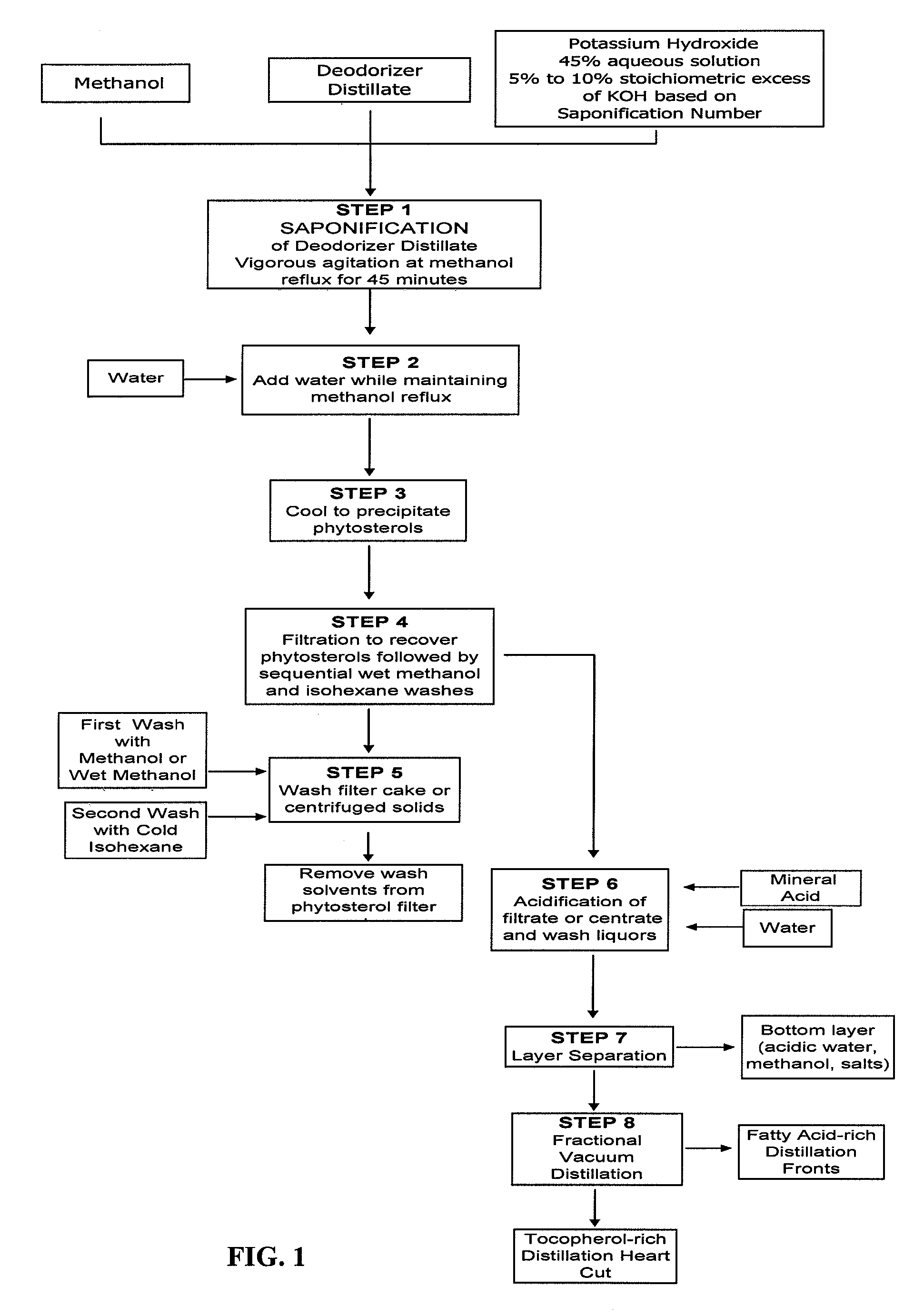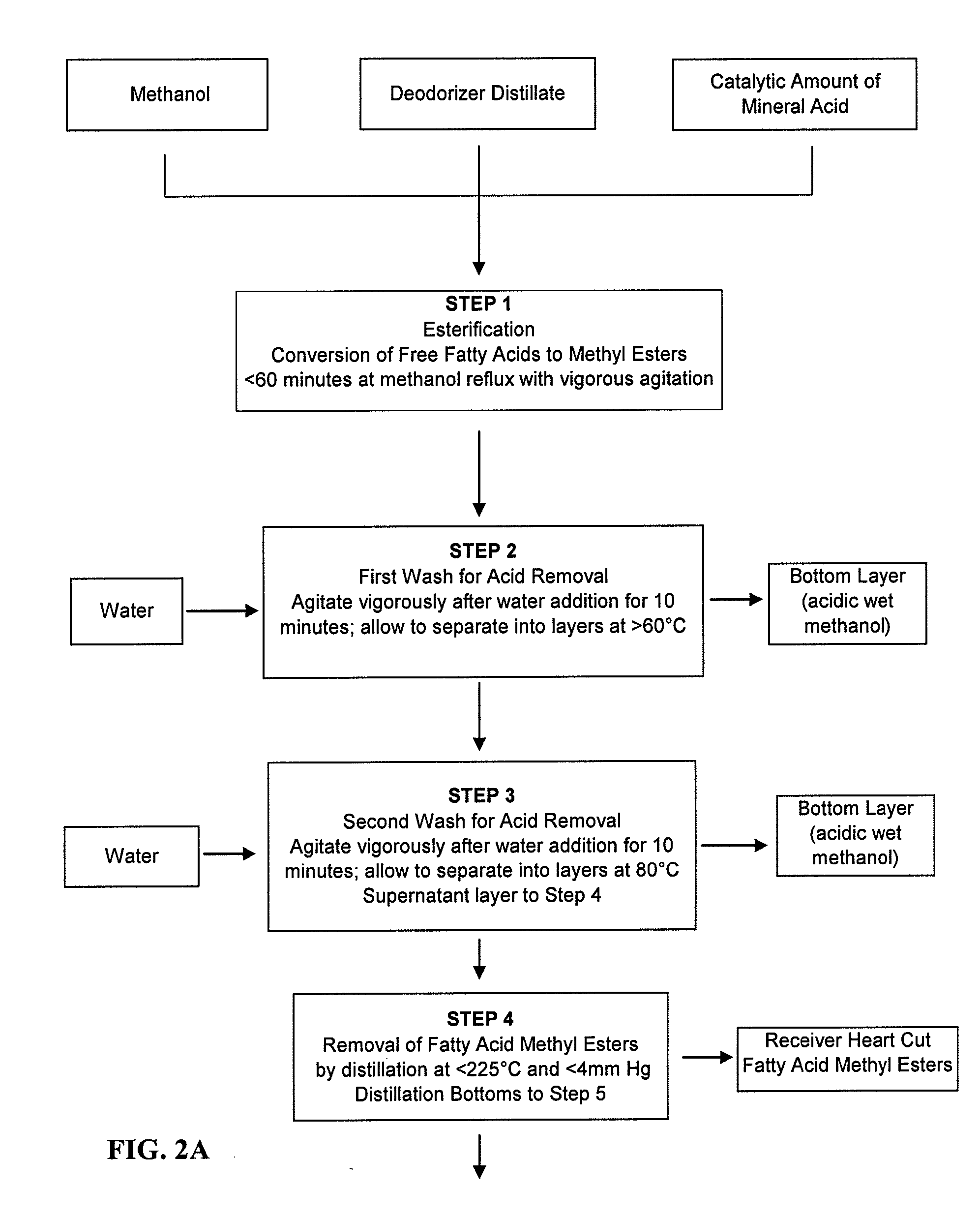Process for isolating phytosterols and tocopherols from deodorizer distillate
a technology of distillate and phytosterols, which is applied in the direction of steroid, chemistry apparatus and processes, organic chemistry, etc., can solve the problems of inability to achieve direct isolation of phytosterols or tocopherols from deodorizer distillates by fractional distillation under reduced pressure, intrinsically difficult to obtain substantially pure phytosterols (or substantially pure tocopherols) by distillation, and poor overall recovery of phytosterols
- Summary
- Abstract
- Description
- Claims
- Application Information
AI Technical Summary
Benefits of technology
Problems solved by technology
Method used
Image
Examples
example 1
[0056] A sample of deodorizer distillate derived from the refining of soybean oil was assayed and determined to have a saponification number of 163, a phytosterol content (both in free form and as phytosterol esters, predominantly the latter) of 16.5% by weight, and a tocopherol content of 6.4% by weight. 1,000 grams of this material was added to 3,000 grams of vigorously stirred methanol contained in a 3-necked flask equipped with a heating mantle, paddle stirrer, thermal well, and reflux condenser. After the temperature of the resulting mixture was increased to 55° C., 398 grams of a 45% by weight aqueous solution of potassium hydroxide (containing 179 grams of dissolved potassium hydroxide, a 10% stoichiometric excess of the amount required to neutralize the free fatty acids and to saponify the esters present) was slowly added. The temperature of the reaction mixture was increased to 66° C. while maintaining vigorous stirring. Once this temperature was achieved, the mixture was a...
example 2
[0060] A sample of deodorizer distillate derived from the refining of canola oil was assayed and determined to have a saponification number of 172, a phytosterol content (both in free form and as phytosterol esters, predominantly the latter) of 14.2% by weight, and a tocopherol content of 5.8% by weight. 1,000 grams of this material was added to 2,500 grams of vigorously stirred methanol contained in a 3-necked flask equipped with a heating mantle, paddle stirrer, thermal well, and reflux condenser. After the temperature of the resulting mixture was increased to 55° C., 420 grams of a 45% by weight aqueous solution of potassium hydroxide (containing 189 grams of dissolved potassium hydroxide, a 10% stoichiometric excess of the amount required to neutralize the free fatty acids and to saponify the esters present) was slowly added. The temperature of the reaction mixture was increased to 66° C. while maintaining vigorous stirring. Once this temperature was achieved, the mixture was al...
example 3
[0064] A sample of deodorizer distillate derived from the refining of soybean oil was assayed and determined to have a saponification number of 163, a phytosterol content (both in free form and as phytosterol esters, predominantly the latter) of 16.5% by weight, and a tocopherol content of 6.4% by weight. One kilogram of this material was added to 500 grams of methanol containing 15 grams of concentrated sulfuric acid and refluxed for 45 minutes with vigorous stirring. Analysis of an aliquot of the mixture was analyzed by gas chromatography revealed a 93% conversion of free fatty acids to their corresponding methyl esters. 100 milliliters of de-ionized water was added and the mixture was agitated vigorously for ten minutes, then charged to a separatory funnel. The bottom aqueous layer containing sulfuric acid was removed and discarded. A second wash using 200 milliliters of de-ionized water was performed to ensure the thorough removal of sulfuric acid.
[0065] The fatty acid methyl e...
PUM
 Login to View More
Login to View More Abstract
Description
Claims
Application Information
 Login to View More
Login to View More - R&D
- Intellectual Property
- Life Sciences
- Materials
- Tech Scout
- Unparalleled Data Quality
- Higher Quality Content
- 60% Fewer Hallucinations
Browse by: Latest US Patents, China's latest patents, Technical Efficacy Thesaurus, Application Domain, Technology Topic, Popular Technical Reports.
© 2025 PatSnap. All rights reserved.Legal|Privacy policy|Modern Slavery Act Transparency Statement|Sitemap|About US| Contact US: help@patsnap.com



